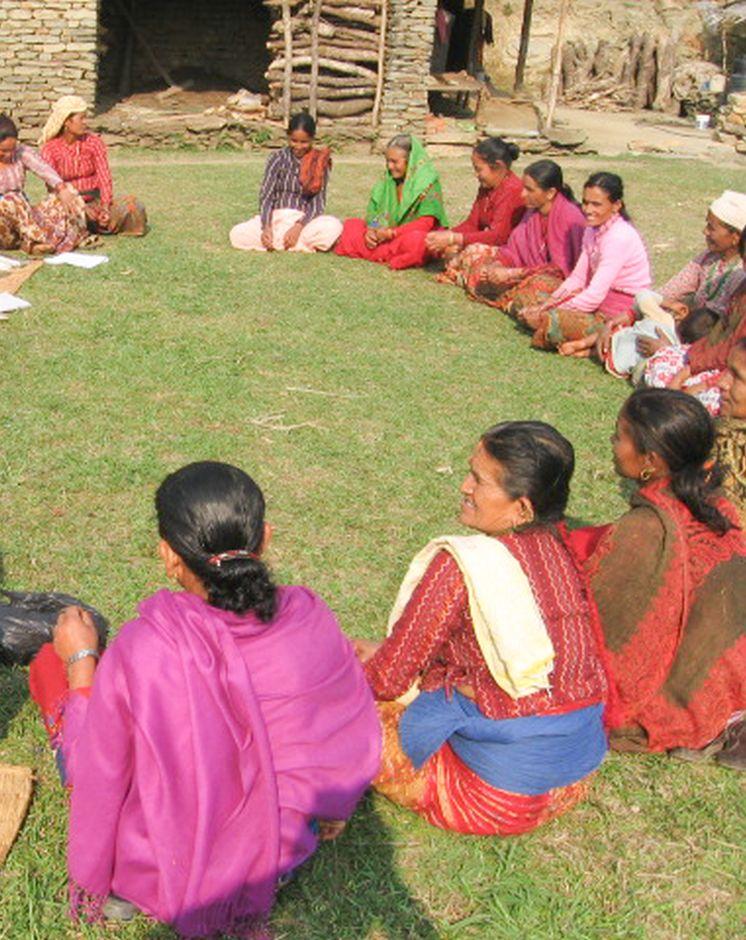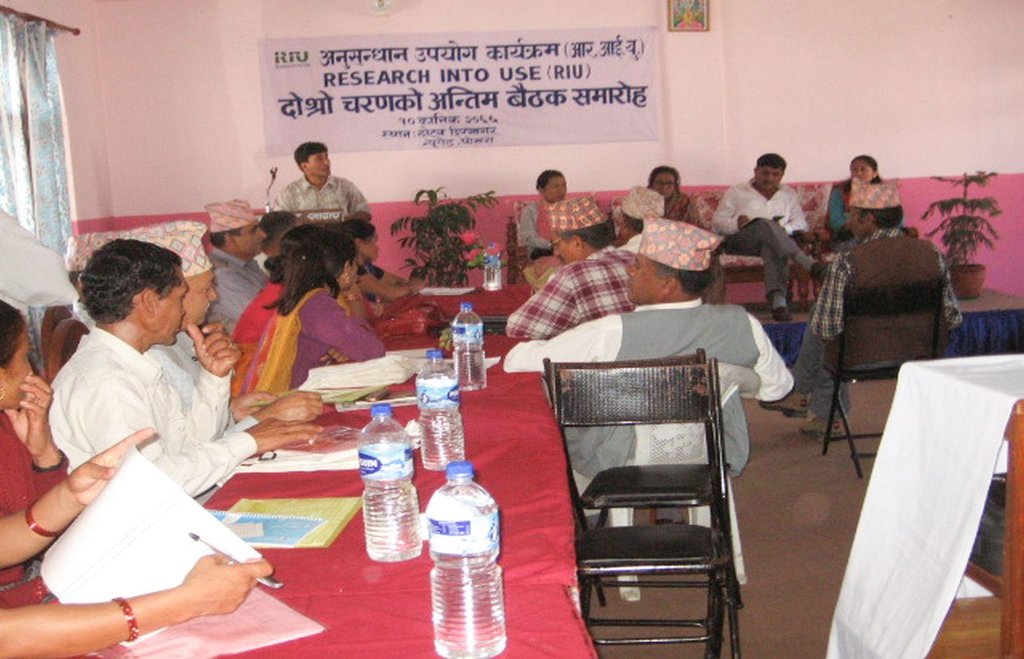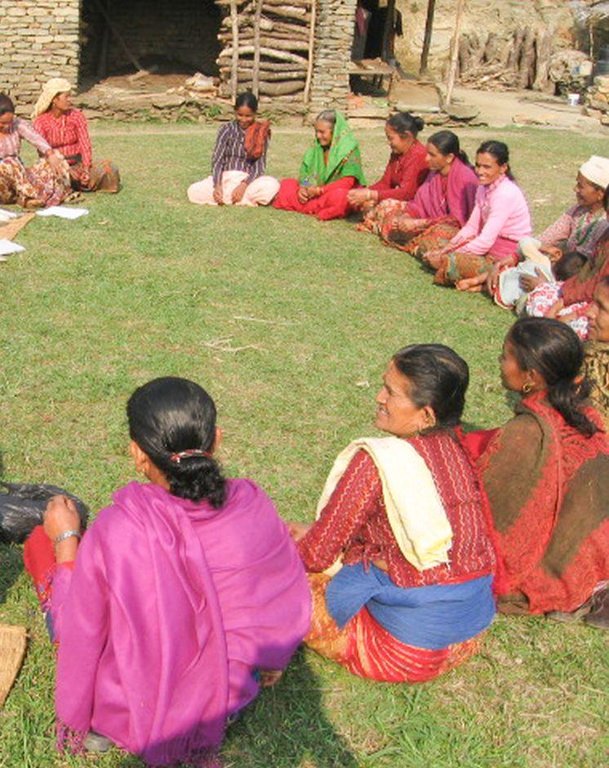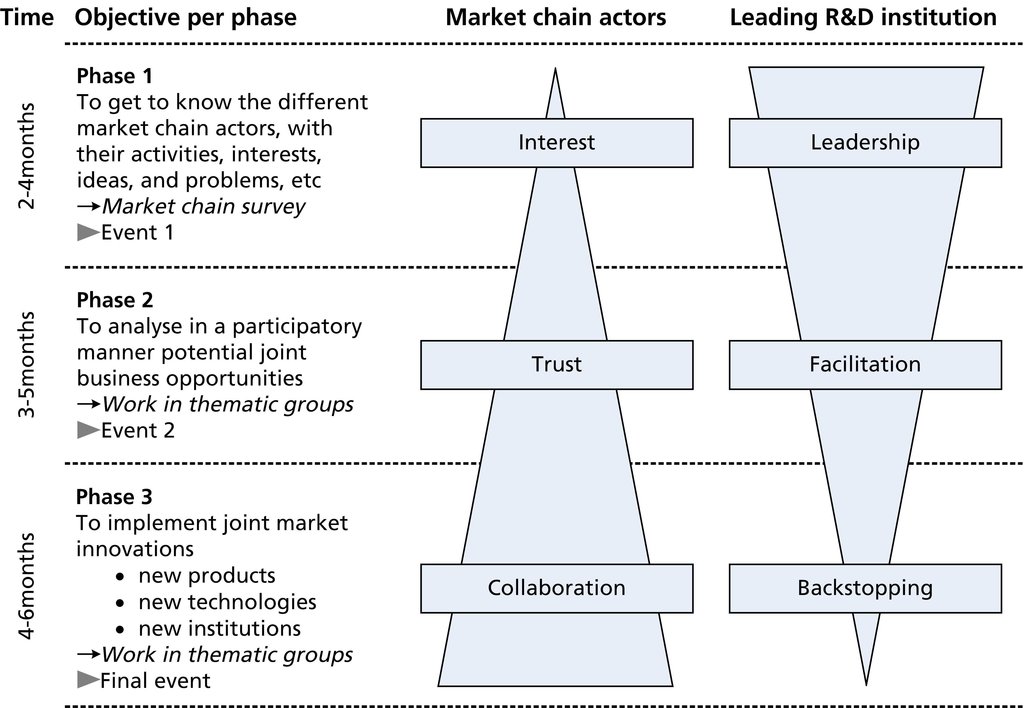Using the participatory market chain approach to help smallholder farmers market their produce [เนปาล]
- ผู้สร้างสรรค์:
- การอัพเดท:
- ผู้รวบรวม: Shreedip Sigdel
- ผู้เรียบเรียง: –
- ผู้ตรวจสอบ: Fabian Ottiger
tarakari sahachetrama sahabhagitatmak bajar sanjal bidhi ko prayog (Main Contributor: Bharat Nepal, IDE/Nepal)
approaches_2533 - เนปาล
ดูส่วนย่อย
ขยายทั้งหมด ย่อทั้งหมด1. ข้อมูลทั่วไป
1.2 รายละเอียดที่ติดต่อได้ของผู้รวบรวมและองค์กรที่เกี่ยวข้องในการประเมินและการจัดเตรียมทำเอกสารของแนวทาง
ผู้เชี่ยวชาญ SLM:
Nepal Bharat
+977 61526537, +977 15520943 (KTM)
bnepal@idenepal.org
International Development Enterprises (IDE) Nepal, Research Into Use (RIU) Project
Regional Office, Pokhara, Kaski; PO Box No. 2674, Kathmandu, Nepal
เนปาล
ชื่อของโครงการซึ่งอำนวยความสะดวกในการทำเอกสารหรือการประเมินแนวทาง (ถ้าเกี่ยวข้อง)
ICIMOD International Centre for Integrated Mountain Development (ICIMOD) - เนปาลชื่อของโครงการซึ่งอำนวยความสะดวกในการทำเอกสารหรือการประเมินแนวทาง (ถ้าเกี่ยวข้อง)
iDE Nepal (iDE Nepal) - เนปาล1.3 เงื่อนไขที่เกี่ยวข้องกับการใช้ข้อมูลที่ได้บันทึกไว้ผ่านทาง WOCAT
วันที่เก็บรวบรวมข้อมูล (ภาคสนาม):
01/03/2013
ผู้รวบรวมและวิทยากรหลักยอมรับเงื่อนไขเกี่ยวกับการใช้ข้อมูลที่ถูกบันทึกผ่านทาง WOCAT:
ใช่
1.4 การอ้างอิงถึงแบบสอบถามเรื่องเทคโนโลยี SLM
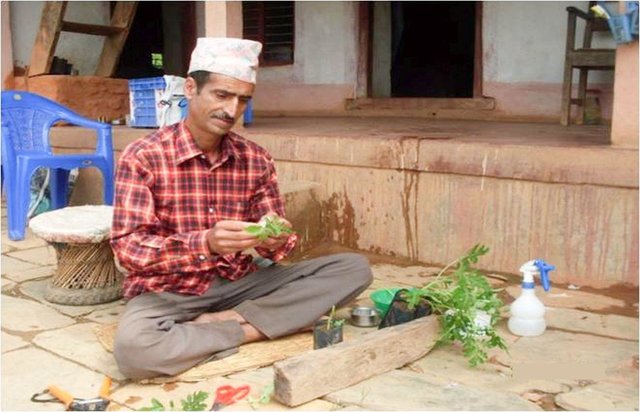
Tomato Grafting [เนปาล]
Cleft grafting can be used to produce plants that are resistant to a number of pests and diseases and are often higher yielding than the original. Tomato seedlings can be easily grafted onto resistant root stock of the wild eggplant (Solanum sysimbrifolium) to produce a disease-resistant and commercially viable crop.
- ผู้รวบรวม: Shreedip Sigdel
2. คำอธิบายของแนวทาง SLM
2.1 การอธิบายแบบสั้น ๆ ของแนวทาง
Discussions and structured interactions between farmers and the different actors involved throughout the market chain can help to stimulate joint innovations based on shared ideas and mutual trust.
2.2 การอธิบายอย่างละเอียดของแนวทาง
การอธิบายอย่างละเอียดของแนวทาง:
Aims / objectives: Most Nepalese rural smallholder landowners are subsistence farmers; when they attempt to produce high value crops such as vegetables for income generation they are often disappointed because they end up selling their produce at local markets for marginal profits. They mostly work alone and, for the most part, their efforts are poorly rewarded, since every step of the value chain is either unmanaged, badly structured, or otherwise uncoordinated. A first step towards addressing the myriad challenges and special needs faced by these smallholder farmers can be to use an adapted version of the participatory market chain approach (PMCA). This approach can help them to improve their livelihoods by building their capacity and assisting them to coordinate and form linkages with other smallholder producers and actors all along the market chain.
Methods: The participatory market chain approach uses the tools of rapid market assessment, focus group discussions, stakeholder interviews, and interaction workshops to help identify the constraints and opportunities faced by each of the different actors in the market chain. This approach uses a set of guidelines to help achieve well-defined objectives at specific points as the programme is implemented.
Stages of implementation: Overall, the long-term objective of the PMCA is to help alleviate the poverty of smallholder producers by introducing market chain innovations, and in particular participation and collaboration among the different market chain actors. Once a given set of conditions is found to work, they can benefit a larger number of farmers if the findings are documented and disseminated among organizations and agencies who share the same goals.
The PMCA approach is executed in three phases:
Phase 1: The different actors along the market chain get to know each other. They analyse their situation with the help of market chain sketch tools. By the end of Phase 1, they form a thematic group.
Phase 2: The group analyses potential business opportunities by using a variety of tools such as: rapid market appraisal, quantitative market survey/study, and focus group discussions.
Phase 3: They put into practice the work plan that they have devised to implement the proposed innovations and continue to work on ideas for commercially viable products using the market concept and business plan development tools.
2.3 รูปภาพของแนวทาง
2.5 ประเทศ ภูมิภาค หรือสถานที่ตั้งที่ได้นำแนวทางไปใช้
ประเทศ:
เนปาล
ข้อมูลเฉพาะเพิ่มเติมของสถานที่ตั้ง:
Bhalam and Dhikurpokhari VDC, Kaski District,
2.7 ประเภทของแนวทาง
- ใช้โครงงานหรือแผนงานเป็นฐาน
2.8 เป้าหมายหรือวัตถุประสงค์หลักของแนวทาง
The Approach focused mainly on other activities than SLM (marketing of agricultural commodities)
• Develop collection centres at the local level
• Strengthen linkages with the concerned development agencies, service providers, and related market chain actors
• Help smallholder farmers to work with a market-led production plan
• Summarize and share the information gathered with the concerned development organizations in order to scale up the approach
• Develop an action plan based on discussions held with thematic group members and market chain actors
The SLM Approach addressed the following problems: • At the local level, the markets are poorly structured and poorly managed; there is a lack of systematic marketing for agricultural commodities.
• There is little knowledge of post-harvest processing which would add value to agricultural produce.
• The links and coordination between service providers, market actors, and stakeholders are poor.
• There is insufficient knowledge of institutional development and of the import role it plays in getting products to market.
• Smallholder farmers do not have access to pricing information.
• Distrust and misunderstanding prevail at every step along the market chain.
2.9 เงื่อนไขที่เอื้ออำนวยหรือเป็นอุปสรรคต่อการนำเทคโนโลยีภายใต้แนวทางนี้ไปปฏิบัติใช้
บรรทัดฐานและค่านิยมทางสังคม วัฒนธรรม ศาสนา
- เป็นอุปสรรค
Smallholder producers have little experience selling their produce at larger markets.
Treatment through the SLM Approach: Strengthen community-based collection centres for collective marketing.
การมีไว้ให้หรือการเข้าถึงแหล่งการเงินและบริการ
- เป็นอุปสรรค
There is no support that smallholder farmers can count on to market their produce.
Treatment through the SLM Approach: Inform farmers of the possibility of participating in programmes like PMCA to extend their networking.
การจัดตั้งระดับองค์กร
- เป็นอุปสรรค
Weak institutional collaboration among line agencies; market and planning committees only function irregularly.
Treatment through the SLM Approach: Facilitate better management of market and planning committees so that the local collection centre can function well.
กรอบแนวทางในการดำเนินการด้านกฎหมาย (การถือครองที่ดิน สิทธิในการใช้ที่ดินและน้ำ)
- เอื้ออำนวย
The approach does not deal specifically with water or land use rights. When these are problematic they are referred to the concerned authorities on a case-by-case basis.
ความรู้เกี่ยวกับ SLM การเข้าถึงการสนับสนุนด้านเทคนิค
- เป็นอุปสรรค
Inadequate information on market-led production and post-harvest processing; poor links with markets.
Treatment through the SLM Approach: Disseminate pricing information; provide training on postharvest processing; give smallholder farmers an opportunity to visit commercial vegetable production sites and different market outlets and allow them to interact with market chain actors and other land users.
อื่นๆ
- เป็นอุปสรรค
Distrust, misunderstanding and poor communication are prevalent in interactions between smallholder farmers, traders, service providers, and those in development agencies.
Treatment through the SLM Approach: Facilitate frequent interactions between vegetable producers, market and planning committee members, and traders to help break down barriers and build trust; facilitate the development of plans for joint implementation.
3. การมีส่วนร่วมและบทบาทของผู้มีส่วนได้ส่วนเสียที่เกี่ยวข้อง
3.1 ผู้มีส่วนได้ส่วนเสียที่เกี่ยวข้องในแนวทางนี้และบทบาท
- ผู้ใช้ที่ดินระดับท้องถิ่นหรือชุมชนระดับท้องถิ่น
A majority of the participants (>60%) were women who are involved at different points along the market chain. More than 20% who participated are from disadvantaged groups.
- ผู้เชี่ยวชาญ SLM หรือที่ปรึกษาการเกษตร
- องค์กรพัฒนาเอกชน
- องค์การระหว่างประเทศ
3.2 การเกี่ยวข้องของผู้ใช้ที่ดินระดับท้องถิ่นหรือชุมชนระดับท้องถิ่นในช่วงต่างๆของแนวทาง
| ความเกี่ยวข้องของผู้ใช้ที่ดินระดับท้องถิ่นหรือชุมชนระดับท้องถิ่น | ระบุผู้ที่มีส่วนเกี่ยวข้องและอธิบายกิจกรรม | |
|---|---|---|
| การริเริ่มหรือการจูงใจ | ปฏิสัมพันธ์ | Public meetings, focus group discussions, interviews, market surveys and rapid market assessments, impact filters |
| การวางแผน | ระดมกำลังด้วยตนเอง | Market constraints and opportunities are identified; actors throughout the market chain and members of thematic groups develop future plans based on their assessment of the business potential for local products and services. |
| การดำเนินการ | ระดมกำลังด้วยตนเอง | The PMCA is implemented through the Marketing Planning Committee and collection centres by various actors from throughout the market chain and members of the various thematic groups; skilled staff from the R&D organization helps with facilitation. |
| การติดตามตรวจสอบหรือการประเมินผล | ระดมกำลังด้วยตนเอง | Members of the various thematic groups and the MPC jointly monitor and evaluate plans and achievements on a regular basis. |
| Research | ปฏิสัมพันธ์ | The approach is applied by the thematic groups. R&D organizations help these groups to analyse both quantitative and qualitative information. |
3.3 แผนผังแสดงขั้นตอนการทำงาน (ถ้ามี)
คำอธิบาย:
The PMCA approach facilitates and promotes trust among market chain actors and allows them to work together to introduce innovative new ideas. During the initial phase, it is usually R&D organizations that take the lead, but as the approach matures, there is an ever greater involvement of the community. The PMCA process supports the development and implementation of institutional, technological, and commercial innovations and has acted to promote constructive interactions through mutual learning and trust.
(AK Thaku)
3.4 การตัดสินใจเลือกใช้เทคโนโลยี SLM
ระบุผู้ที่ทำการตัดสินใจเลือกเทคโนโลยีมากกว่าหนึ่งวิธีไปปฏิบัติใช้:
- ผู้เชี่ยวชาญ SLM เป็นผู้ตัดสินใจหลัก ที่ติดตามให้คำปรึกษากับผู้ใช้ที่ดิน
การอธิบาย:
Initially, the choice of the PMCA approach was made by national and international specialists in consultation with local people. It was first offered by a research and development organization, but as everyone came to see how valuable it was, it was eventually taken on by local people and is now offered by various groups to everyone throughout the market chain.
Decisions on the method of implementing the SLM Technology were made by mainly by SLM specialists with consultation of land users
4. การสนับสนุนด้านเทคนิค การสร้างขีดความสามารถ และการจัดการด้านความรู้
4.1 การสร้างขีดความสามารถ / การอบรม
ได้มีการจัดอบรมให้แก่ผู้ใช้ที่ดินหรือผู้มีส่วนได้ส่วนเสียคนอื่น ๆ หรือไม่:
ใช่
ให้ระบุว่าใครเป็นผู้ได้รับการอบรม:
- ผู้ใช้ที่ดิน
- เจ้าหน้าที่ภาคสนาม / ที่ปรึกษา
รูปแบบการอบรม:
- เกษตรกรกับเกษตรกร
- ใช้พื้นที่ทำการสาธิต
- จัดการประชุมสู่สาธารณชน
- จัดคอร์ส
4.2 การบริการให้คำแนะนำ
ผู้ใช้ที่ดินมีการเข้าถึงการรับบริการให้คำปรึกษาหรือไม่:
ใช่
ระบุว่ามีบริการให้คำปรึกษาหรือไม่:
- ที่ศูนย์ถาวร
การอธิบาย/แสดงความคิดเห็น:
Name of method used for advisory service: Training and workshop; Key elements: a market-led production plan, technical training for the thematic groups and regular monitoring of land users' fields, facilitation of joint programme planning and implementation.
4.3 การเสริมความแข็งแกร่งให้กับสถาบัน (การพัฒนาองค์กร)
สถาบันได้รับการจัดตั้งขึ้นมาหรือเสริมความแข็งแกร่งโดยแนวทางนี้หรือไม่:
- ใช่ ปานกลาง
ระบุระดับของสถาบันที่ได้รับการเสริมความแข็งแกร่งหรือจัดตั้งขึ้นมา:
- ท้องถิ่น
ระบุประเภทของการให้ความช่วยเหลือสนับสนุน:
- การสร้างขีดความสามารถ / การอบรม
ให้รายละเอียดเพิ่มเติม :
The groups that were given market-centred training, and technical training on high value vegetable production and post harvest processing. Participants included members of village development committees, local governance and community development programmes (LCGDP), community forest users' groups, youth clubs, and women's groups.
4.4 การติดตามตรวจสอบและประเมินผล
การติดตามตรวจสอบและประเมินผลเป็นส่วนหนึ่งของแนวทางหรือไม่:
ใช่
ความคิดเห็น:
technical aspects were monitored through observations; indicators: Commercial production and collective marketing
socio-cultural aspects were monitored through observations; indicators: This approach increased their bargaining power and made them aware of current market prices for their high-value products.
economic / production aspects were monitored through observations; indicators: Market-led production and the application of post harvest processing techniques
area treated aspects were monitored through observations; indicators: The Marketing Planning Committee surveyed the area.
no. of land users involved aspects were monitored through observations; indicators: Some 200–750 farmers were involved in the Market Planning Committee and the collection centre.
management of Approach aspects were monitored through observations; indicators: Various actors from all along the market chain participated; regular observations were made and training was given to facilitate the implementation of innovative activities.
There were several changes in the Approach as a result of monitoring and evaluation: The focus was on the collective marketing of smallholder farmers' vegetable produce. These farmers now work towards market-led production through regular meetings and trainings; they market collectively, and have better post-harvest processing. It is helping to empower women and members of disadvantaged groups and to improve their livelihoods.
4.5 การวิจัย
การวิจัยเป็นส่วนหนึ่งของแนวทางหรือไม่:
ใช่
ให้ข้อมูลเพิ่มเติมและให้ระบุผู้ทำการวิจัย:
This approach is the result of research which took place in Peru and Uganda. It has been adapted to the vegetable sub- sector in Nepal by IDE Nepal in collaboration with local NGOs. Both the government of Nepal and other local NGOs are in the process of adopting and piloting what was learned.
5. การสนับสนุนด้านการเงินและวัสดุอุปกรณ์
5.1 ระบุงบประมาณประจำปีสำหรับแนวทาง SLM นี้
ถ้าหากว่างบประมาณประจำปีไม่เป็นที่ทราบแน่นอน ให้ระบุช่วงลงไป:
- 2,000-10,000
แสดงความคิดเห็น (แหล่งของการระดมทุน ผู้บริจาคคนสำคัญ):
Approach costs were met by the following donors: international non-government: 60.0%; private sector: 10.0%; local government (district, county, municipality, village etc): 10.0%; local community / land user(s): 20.0%
5.2 การสนับสนุนด้านการเงิน / วัสดุอุปกรณ์ให้แก่ผู้ใช้ที่ดิน
ผู้ใช้ที่ดินได้รับการสนับสนุนด้านการเงิน / วัสดุอุปกรณ์ไปปฏิบัติใช้เทคโนโลยีหรือไม่:
ใช่
5.3 เงินสนับสนุนสำหรับปัจจัยนำเข้า (รวมถึงแรงงาน)
ถ้าแรงงานโดยผู้ใช้ที่ดินเป็นปัจจัยนำเข้าที่มีอยู่มากมาย ระบุด้วยว่าเนื่องจาก:
- สมัครใจ
ความคิดเห็น:
The project demonstrated new agricultural technologies only once; after that, the various groups adopted new technologies at their own cost.
5.4 เครดิต
มีการจัดหาเครดิตมาให้ภายใต้แนวทาง SLM หรือไม่:
ไม่ใช่
6. การวิเคราะห์ผลกระทบและการสรุป
6.1 ผลกระทบของแนวทาง
ช่วยให้ผู้ใช้ที่ดินนำเอาเทคโนโลยี SLMไปใช้และบำรุงรักษาสภาพไว้ได้หรือไม่:
- ไม่ใช่
- ใช่ เล็กน้อย
- ใช่ ปานกลาง
- ใช่ อย่างมาก
In districts where the farmers have adopted organic vegetable production, there has been a noted retention of good soil fertility. Valam VDC of Kaski District is one such example.
ทำให้กลุ่มด้อยโอกาสมีอำนาจทางสังคมและเศรษฐกิจหรือไม่:
- ไม่ใช่
- ใช่ เล็กน้อย
- ใช่ ปานกลาง
- ใช่ อย่างมาก
Smallholder farmers are commonly the poorest and most disadvantaged members of any community, and they have benefited from this approach.
Did other land users / projects adopt the Approach?
- ไม่ใช่
- ใช่ เล็กน้อย
- ใช่ ปานกลาง
- ใช่ อย่างมาก
The agricultural component of the Market Access for Smallholder Farmers (MASF) Project which is implemented by IDE (and funded by DFID) has adopted this approach. District level line agencies such as LI-BIRD have also adopted it. Districts in the Eastern Region that adopted agricultural crop and goat programmes include Bara, Rautahat, Siraha, and Saptari Districts.
Did the Approach lead to improved livelihoods / human well-being?
- ไม่ใช่
- ใช่ เล็กน้อย
- ใช่ ปานกลาง
- ใช่ อย่างมาก
When everyone along the market chain collaborates through shared interests and mutual trust to bring better produce to a common market - everyone benefits from the increased opportunities.
Did the Approach help to alleviate poverty?
- ไม่ใช่
- ใช่ เล็กน้อย
- ใช่ ปานกลาง
- ใช่ อย่างมาก
When smallholder farmers sell their produce at collection centres for a fair price they earn more income and, as a result, their livelihoods are improved and poverty is reduced.
6.3 ความยั่งยืนของกิจกรรมของแนวทาง
ผู้ใช้ที่ดินสามารถทำให้สิ่งต่างๆ ที่ได้ปฏิบัติใช้โดยแนวทางนี้ยั่งยืนได้หรือไม่ (โดยไม่มีการสนับสนุนจากภายนอก):
- ใช่
ถ้าตอบว่าใช่ ให้อธิบายว่าอย่างไร :
The approach can be replicated without external support. Once a core group of smallholder farmers understands the approach, they can pass on the know-how to others through regular meetings and other vehicles. The establishment of the collection centre is an activity that should yield benefits for a long time to come.
6.4 จุดแข็งและข้อได้เปรียบของแนวทาง
| จุดแข็ง / ข้อได้เปรียบของแนวทางในทัศนคติของผู้รวบรวมหรือวิทยากรหลัก |
|---|
| Everyone along the market chain is involved in making decisions about the choice of high value crops and their marketing. (How to sustain/ enhance this strength: It is important to continue the regular meetings in order to assure the continued success of the present activities and to introduce innovations.) |
|
The PMCA has proven that it can be a valuable tool for all stakeholders along the market chain to help them design and implement programmes. (How to sustain/ enhance this strength: Lobby the government and other agencies to replicate the PMCA in other areas and agencies.) |
| The approach helped to build relationships and trust among the market chain actors and it led to increased vegetable production and increased earnings for farmers. (How to sustain/ enhance this strength: Upgrading the market planning committee to a cooperative would help to generate more resources from the members.) |
| Farmers sell their produce through the collection centre in a collective marketing approach. (How to sustain/ enhance this strength: If this approach is documented and disseminated, other areas of the country can learn from it and replicate it.) |
6.5 จุดอ่อน / ข้อเสียเปรียบของแนวทางและวิธีในการแก้ไข
| จุดอ่อน / ข้อเสียเปรียบในทัศนคติของผู้รวบรวมหรือวิทยากรหลัก | สามารถแก้ไขปัญหาได้อย่างไร |
|---|---|
|
Smallholder farmers cannot always produce enough high value crops to sell profitably; it can be a challenge to transport crops to the collection centre. |
Farmers need time and support in order to learn how to adopt commercial farming methods and how to market their produce collectively |
| When only smallholder farmers are involved, the meetings of the thematic groups can be sporadic. | Need to involve commercial farmers in the thematic groups. |
|
The PMCA process has not been well documented for replication. |
Clear documentation is necessary so that the results can be replicated in other areas. |
| Smallholder farmers often do not have the means to implement innovations. | Provide some seed money for thematic groups; development organizations who plan to implement the PMCA approach can provide this. |
7. การอ้างอิงและการเชื่อมต่อ
7.1 วิธีการหรือแหล่งข้อมูล
- ไปเยี่ยมชมภาคสนาม การสำรวจพื้นที่ภาคสนาม
- การสัมภาษณ์กับผู้ใช้ที่ดิน
7.2 การอ้างอิงถึงสิ่งตีพิมพ์
ชื่อเรื่อง ผู้เขียน ปี ISBN:
Participatory market chain approach (PMCA): user guide (unpublished). Kathmandu, Nepal: IDE Nepal, RIU Project, Thomas, T; Graham, T; Thomas, Z (no date)
ลิงก์และโมดูล
ขยายทั้งหมด ย่อทั้งหมดลิงก์

Tomato Grafting [เนปาล]
Cleft grafting can be used to produce plants that are resistant to a number of pests and diseases and are often higher yielding than the original. Tomato seedlings can be easily grafted onto resistant root stock of the wild eggplant (Solanum sysimbrifolium) to produce a disease-resistant and commercially viable crop.
- ผู้รวบรวม: Shreedip Sigdel
โมดูล
ไม่มีโมดูล


